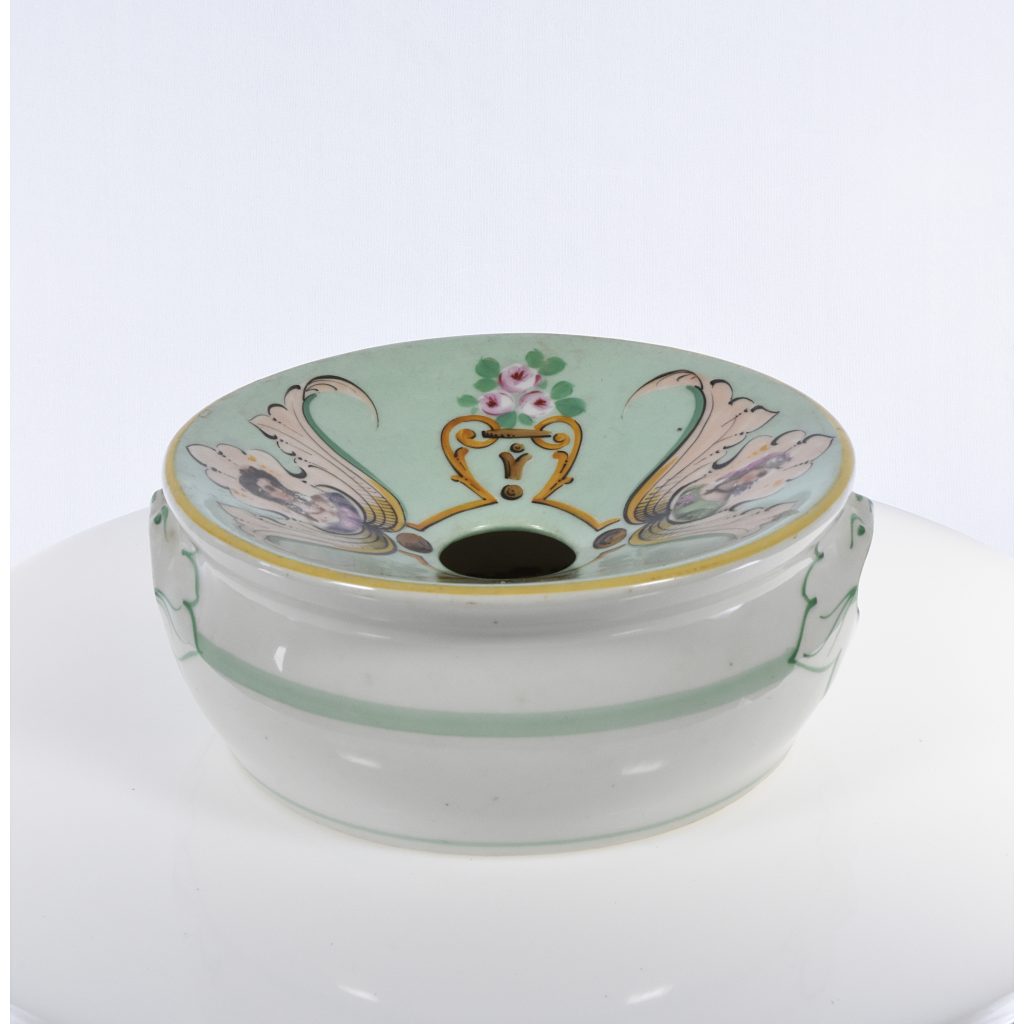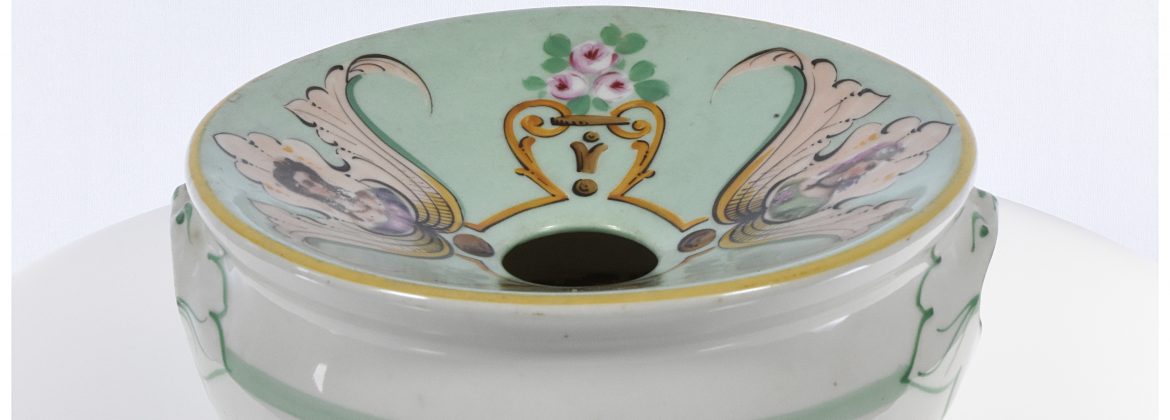
Autor: Desconhecido Material/Técnica: Porcelana/ pintura/ Verde
Século: XIX
Procedência: Acervo pessoal de Dom Aquino Corrêa
Dimensão: 9x20cm
Dados Históricos: Escarrador ou escarradeira, cuspidor ou cuspideira, estes, são os nomes pelos quais são conhecidos estes objetos, que serviam sobretudo para recolher a expectoração, numa altura em que cuspir para o chão era um hábito “normal”. Hoje, peças de museu, de casas de antiguidades e de colecionadores, que caíram em desuso há muito tempo, mas que fazem parte da história social de uma época, sobretudo do século XIX e da 1ª metade do século XX. Estas peças que fizeram parte dos utensílios de mobiliário das casas mais abastadas e dos lugares públicos, como teatros, quartéis, hospitais, salões, hotéis e instituições públicas, como é o caso deste exemplar, pertencente ao acervo museológico da Caixa Geral de Depósitos e utilizado nas diversas agências. Tinham uma grande diversidade, simples ou profusamente decorados, em porcelana, vidro ou metal nobre. Havia escarradores de uso pessoal e coletivo. Os de bolso, eram pequenos frascos de vidro ou pequenas caixas de ferro, com areia ou serradura, utilizadas por quem usava tabaco de mascar, para as beatas dos cigarros ou para expectorar. Os médios, de mesa de cabeceira e os grandes, de uso coletivo que continham no seu interior um líquido antisséptico. O seu uso vulgarizou-se em vários países, com as primeiras campanhas antituberculose, por se supor que a passagem para a atmosfera do bacilo de Koch ( identificado em 1882 por Robert Koch) através da saliva e do espirro, era uma das principais causas de contágio da doença que provocava uma grande mortalidade. Em Portugal, no final do século XIX e início do século XX, a tuberculose ou “tísica” causou uma enorme preocupação pública. Numa tentativa de reduzir o contágio da doença, foram tomadas diversas medidas: isolamento, tratamento e prevenção. Criaram-se centros hospitalares e sanatórios, implementaram-se regras e estratégias sociais de educação alimentar, sanitária, higiene física e mental das populações, notificação obrigatória da doença, tudo, numa tentativa de melhorar a qualidade de vida e evitar a sua proliferação (da doença), para a qual contribuiu muito o empenho da Rainha D. Amélia, no final do século XIX. Assim, surgem os escarradores como objetos obrigatórios nos locais públicos, e numa tentativa de terminar com o insalubre costume de cuspir para o chão e de propagação do vírus da tuberculose. É promulgado um edital em 14 de fevereiro de 1902, assinado pelo Governador Civil de Lisboa, que proibia o escarrar e cuspir fora dos escarradores próprios, sob pena de 500 réis de multa.
Author: Unknown
Material/Technical: Porcelain/painting/Green
19th Century
Origin: Personal collection of Don Aquino Corrêa
Dimension: 9x20cm
Historical Data: Spit or spittoon, spit or spit, these are the names by which these objects are known, which served above all to collect sputum, at a time when spitting on the floor was a “normal” habit. Today, pieces from museums, antique houses and collectors, which fell into disuse a long time ago, but which are part of the social history of an era, especially in the 19th century and the 1st half of the 20th century. These pieces that were part of the furniture utensils of the most affluent houses and public places, such as theaters, barracks, hospitals, halls, hotels and public institutions, such as this example, belonging to the museum collection of Caixa Geral de Depósitos and used in the various agencies. They had a great diversity, simple or profusely decorated, in porcelain, glass or noble metal. There were sputters for personal and collective use. The pocket ones were small glass bottles or small iron boxes, with sand or sawdust, used by those who used chewing tobacco, for cigarette butts or to expectorate. The medium ones, of the bedside table and the large ones, of collective use that contained an antiseptic liquid inside. Its use became common in several countries, with the first anti-tuberculosis campaigns, as it was assumed that the passage into the atmosphere of the Koch bacillus (identified in 1882 by Robert Koch) through saliva and sneezing, was one of the main causes of contagion of the disease that caused a great mortality. In Portugal, at the end of the 19th century and the beginning of the 20th century, tuberculosis or “tisica” caused enormous public concern. In an attempt to reduce the spread of the disease, several measures were taken: isolation, treatment and prevention. Hospitals and sanatoriums were created, social rules and strategies for food education, health, physical and mental hygiene of the populations, mandatory notification of the disease were implemented, all in an attempt to improve the quality of life and prevent its proliferation (of disease), to which Queen D. Amélia’s efforts at the end of the 19th century contributed greatly. Thus, sputum emerges as mandatory objects in public places, and in an attempt to end the unhealthy habit of spitting on the ground and spreading the tuberculosis virus. An edict is promulgated on February 14, 1902, signed by the Civil Governor of Lisbon, which forbade spitting and spitting outside its own sputumers, under penalty of 500 réis fine.

